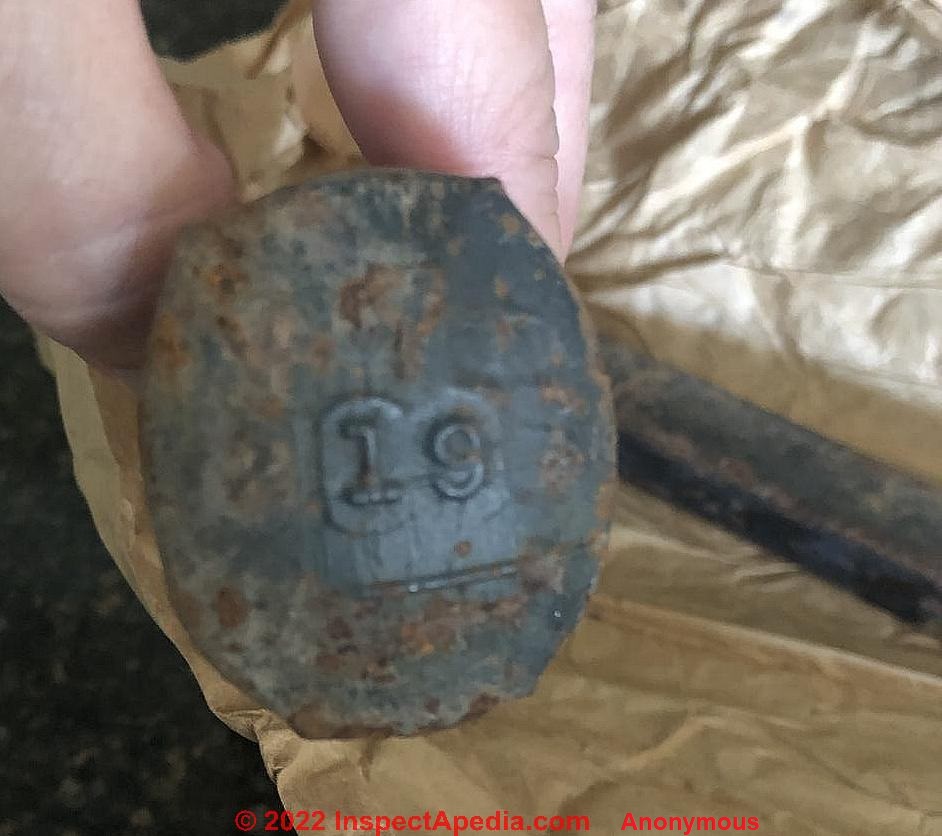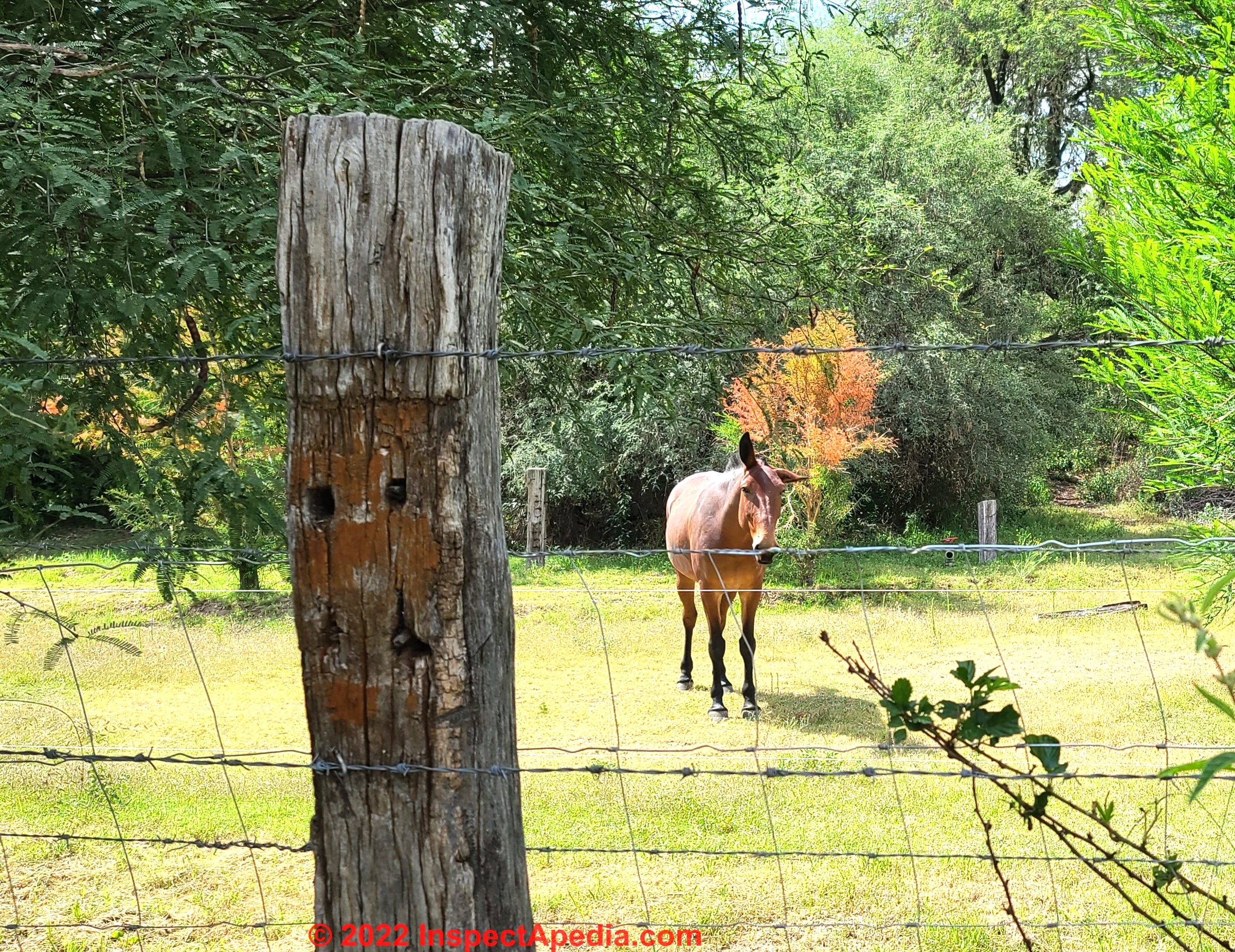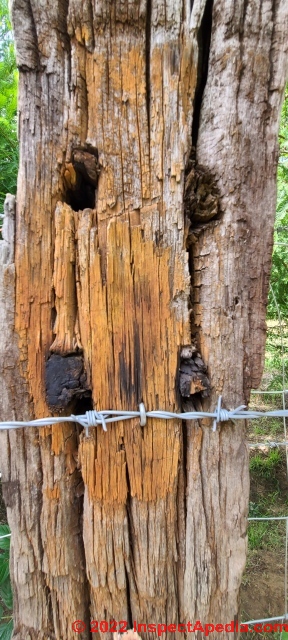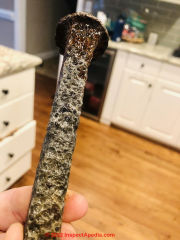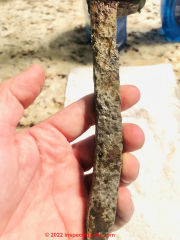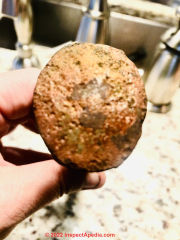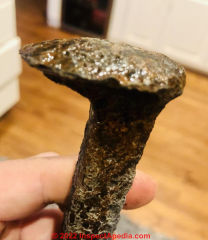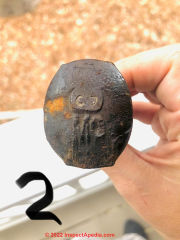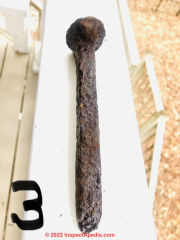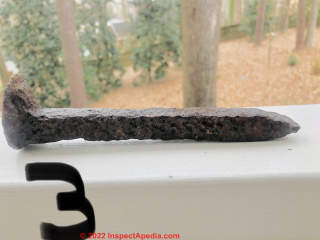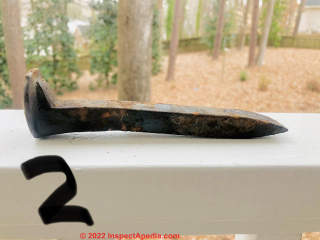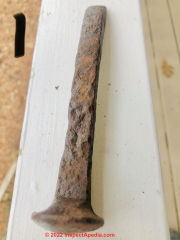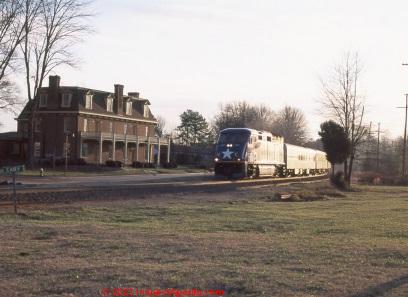 Railroad Spikes: Contextual Clues
Railroad Spikes: Contextual Clues
Use contextual clues to date railway spikes and other nails
- POST a QUESTION or COMMENT about determining age of antique nails & spikes
Use of contextual clues in the identification of railroad spikes.
This article series describes how contextual clues can help in the identification and age determination of railroad spikes and other nails.
InspectAPedia tolerates no conflicts of interest. We have no relationship with advertisers, products, or services discussed at this website.
- Daniel Friedman, Publisher/Editor/Author - See WHO ARE WE?
Contextual Clues in Dating Railroad Spikes
Separately at NAIL AGE DETERMINATION KEY we explain that when estimating the age, properties, use, and history of a metal fastener like a nail or a railroad spike, we look at both the fastener itself and its properties and also at the surrounding information that gives some context to a guess at the object's age.
Photo: Railroad spike found behind the Shawnee OK railroad depot, black-coated, with the numbers 19 embossed into the spike head.
[Click to enlarge any image]
When guessing at the age of a railroad spike, take a look at:
1. The railroad spike itself offers clues about its age, history & how it was made
I refer to such as details about head shape, cross section, burr marks, tool marks.
In the case of railroad spikes, these fasteners look pretty much the same since early in the history of railroads.
As soon as the railroads abandoned conventional nails and wooden pegs (those were found to loosen quickly and badly), say by the 1830s in North America, rectangular spikes with an offset head were common, following the spike design attributed to Stevens.
Wooden pegs still at work
As mentioned above, wooden pegs for use in railroads were replaced wtih stronger, longer lasting metal spikes. These old and rarer to find wooden pegs are still in existence in some places although perhaps being used for a different purpose.
A horse pasture that borders the Rio Laja near San Miguel de Allende in Guanajuato, Mexico, gives us a good example of this. These vertical fence posts are old railroad ties now repurposed as fencing.
These railroad ties are interesting because they sport wooden pegs that tied the railroad rail plates to the ties - as visible in two of the 3 photos, suggesting that they are quite old, but still in use, now forming posts that carry a fence around this horse pasture.
Although we don't know when this pasture fence was erected, we do know that the materials used would date from before the 1830s when more durable metal spikes began to be used instead.
What was wooden railroad spike used for?
I was walking on railroad tracks and I found a wooden railroad spike what was it used for? It looks identical to the metal ones. Reader Duane on 10/29/2022
Moderator Reply:
@Duane,
The earliest railroads attempted to use wooden spikes to secure the rails to the ties. It was quickly found that using wooden pegs or spikes to secure the rail plates to railroad ties was not a durable method.
It's possible but it would be quite unusual to find an actual wooden railroad spike still intact since we are talking about details from over 150 years ago.
Our photos above show an example of this unusual detail: wooden railroad tie spikes still visible in these antique railroad ties.
Perhaps you could post a photo.
Rectangular railroad spikes with an offset head: Dog Spikes
Later variations in the Stevens railroad spike included railroad spikes with a shorter head and outwards-facing lugs that eased the removal of the spike during track work - the "dog spike".
I find that the term "dog spike" refers to spikes with a head intended to make removal easier by having an offset edge to one side of the spike, but as those are so widely used I'm not sure it's a helpful spike age marker.
And I would not assume that just because your railroad spike is a dog-spike, that it's older.
Clues to railroad spike metallurgy
Railroad spike metallurgy is another clue to spike age. Earlier railroad spikes were made of a soft-steel, often marked with a letter or logo that identifies its manufacturer.
High-carbon or HC railroad spikes will also bear a brand or letters identifying the spike's manufacturer, but you'll often find an H (or perhaps HC) embossed into the spike head a well.
High-carbon railroad spikes are also higher in copper than older soft-iron spikes, so you may find them in better condition, with less rust and corrosion.
Really? Well yes and no. When the railroad spike is hammered into the tie the letters or numbers marked into the spike's head will often have been smashed to near-invisibility.
Hardware accompanying the railroad spike may identify its age
Look closely at any surrounding hardware such as keys used with the spike to improve its holding power - review those against the railroad spike patents listed above on this page.
Look at the tie plate details if tie plates are found with the spike or nearby.
Look for date nails on railroad ties that may be nearby. (More on date nails is just below).
2. Contextual clues surrounding the railroad spike help guess RR spike age & history
What do we know from surrounding materials, location, history of the area, etc.
Here we're often in better shape. Most railroad spikes found in- or near-situ will be along a railroad right-of-way. Usually the name of the right-of-way and the railroad that built it and its history are a matter of public record and are easily found. Knowing when a right-of-way was constructed by a railroad gives us a probable earliest date of spikes found in that area.
If you find railroad rail tie plates in the same area as your spike then it's a fair guess that the earliest date you'd put on that spike (in the U.S.) would be in th 1900s when tie plates came into widespread use.
And of course modern concrete railroad ties and rail clip fasteners will be newer.
On railroads where you can find older ties still in place, look for a date nail hammered into some of the ties themselves. Date nails were used in railroad ties as early as 1901 as a means of tracking the age of ties and thus planning for their replacement as part of railway maintenance.
The first recorded date nail used in a U.S. cross tie dates from 1897 and was used on the Mississippi River & Bonne Terre Railroad. No other railroad used them until 1899.
Octave Chanute who was involved with the tie treatment process as well as aviation innovations and other cutting edge programs of the time was credited with introducing the use of the date nail to the railroads at a Maintenance of Way convention in 1900. - Meyers, Rolland, Date Nails, retrieved 2022/06/07, original source: https://www.rta.org/assets/docs/Other/date nail history cohs.pdf Email: rolland@rollandmeyers.com
Age of nail's surrounding materials - contextual information
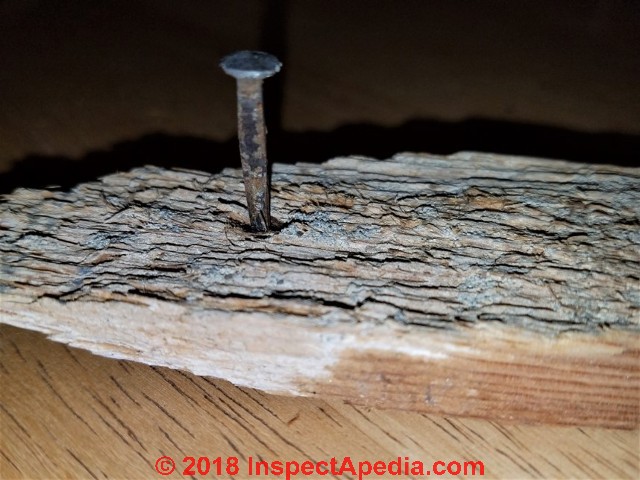 If the nail was found in a building, what is the age of the building and when were renovations or additions made to the building?
If the nail was found in a building, what is the age of the building and when were renovations or additions made to the building?
Also what type of building was it: home, barn, commercial structure, deck, wharf, ship, boat, or even an antique aircraft?
What is the history of the area where the nail or spike was found? See our examples below
at ESOPUS MEADOWS LIGHTHOUSE ISLAND SPIKE - using historical context of surroundings to guess the purpose and age of iron nails artifacts.
Take a look at this little antique cut nail - it's twisted so you may be fooled but this is a machine made but small cut nail.
Look at where it's found: this is a strip of wood lath.
So we can be pretty sure that this is a lath nail. The increase in width below the cut nail head followed again by decrease tells us something about the manner in which this cut nail was sliced from the iron blank and thus more about its age, as we'll explain below.
Now if this lath scrap is, for example, from an old house I restored at 28 West St. in Wappingers Falls NY (known as "the bleachery"), we know when that house was built and thus we can make a pretty good guess that original wood lath in the home dates from around the U.S. Civil War, perhaps 1865 to about 1880.
Incidentally if you look closely you'll see the saw cut kerf marks faintly visible on this wood lath.
After making what use you can of surrounding mud, dirt, debris to understand the nail's context and history, get the crud off to get a better look at the nail.
...
Reader Comments, Questions & Answers About The Article Above
Below you will find questions and answers previously posted on this page at its page bottom reader comment box.
Reader Q&A - also see RECOMMENDED ARTICLES & FAQs
On 2023-01-03 by InspectApedia Publisher
@Katherine,
It's really nice to have that additional history, thank you. We'll be sure to keep these notes and your photos with this article series.
And we've moved your questions, photos, and our full discussion above in this article at
"Special Markings, Stamps, Logos on Railroad Spikes"
If your railroad spike was found along the Cary railroad right-of-way, we've got a pretty good idea of the possible time frame - oldest or newest - for your RR spike. From its corrosion, we might speculate that your spike is one of the earlier ones, both from the degree of corrosion and possibly from a difference in metallurgy.
On 2023-01-03 by Katherine
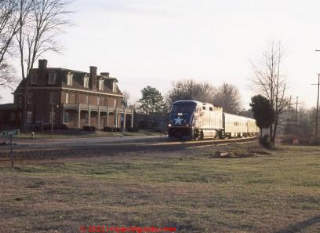 Well here's the relevant history: Chartered in 1849, the railroad right-of-way was surveyed through Cary in 1851. Beginning in 1853, steam engine train service started along the entire 223 mile-line in 1856. The railroad literally put Cary on the map. By 1860, a rural depot had been established.
Well here's the relevant history: Chartered in 1849, the railroad right-of-way was surveyed through Cary in 1851. Beginning in 1853, steam engine train service started along the entire 223 mile-line in 1856. The railroad literally put Cary on the map. By 1860, a rural depot had been established.
Frank Page (Cary's founder) was the agent, so it became known as Page’s Turnout. In 1862, NCRR prevailed the Southern Express Company to build a telegraph line through Cary. Because the trains began to stop occasionally for passengers, Frank built a small shelter for those waiting for a train to stop for them.
By 1867, there was regular passenger service in Cary. In 1868, a junction was formed in Cary when NCRR allowed the Chatham Railroad to lay tracks “not less than 8 feet from their own,” and to cross the tracks near Cary.
In gratitude, the Chatham railroad (later called the Seaboard) then built a “commodious depot” in Cary. Frank Page sold ten acres of land for the right-of-way for the depot at a cost of $2.00. Over time, the two original railroads changed ownerships and names.
In 1893, the Chatham Railroad became the Seaboard Coast Line System. In 1895, the Richmond and Danville Railroad Company became the Southern Railway Company. In the 1860s, NCRR built what became known as the Southern station.
To the horror of many Cary citizens, it was demolished in 1939. Then both train companies began to use the Seaboard station (the original “commodious depot,” and the name was changed to Union station. Then it was also torn down in 1965.
The current Cary depot was built and opened in 1995.
On 2023-01-03 by Katherine
@InspectApedia Publisher,
Indeed. As I said earlier in the string, these were recovered from the original railroad tracks built through Cary, NC (Wake County) in front of the town founder's home. The railroad came to town in 1854.
On 2023-01-02 by InspectApedia Publisher
@Katherine,
Nice gentle cleaning job. I take it there are no letters or numbers or logos visible on the spike head. About the most we can say is post 1830 and probably rather newer.
When the RR spike itself is mum about its age and history, and what we should be doing anyway is
CONSIDER THE SURROUNDING CONTEXT of the railroad spike to make a reasonable guess about its age and history.
Where was railroad spike found: country, city or town or key geographic feature like a mountain or tunnel ?
What is the railroad line history for that area ?
Were there any surrounding contextual clues like railroad ties, plates, date nails?
On 2023-01-02 by Katherine
Hey it's me again. So I soaked the more corroded two spikes in white vinegar for a few days and it did help reveal textures, although I can see no hints or markings. I looked through the page as you suggested, but I'm not seeing anything that really matches what I'm finding -- but this is the first time I've ever considered railroad spikes.
Was wondering if these new images offer any new insights? I will send as a series of 5 images. Thank you.
On 2022-12-31 by InspectApedia Publisher
@Katherine,
We can't see other clues to offer more than too speculative guesses.
DO take a look at the nail or spike age guesses given
at KEY TO AGE OF ANTIQUE METAL NAILS
to see what you make of those, such as looking for cracks giving direction of iron fibres
DO take a look at the RAILROAD SPIKES article above on this page.
On 2022-12-31 by Katherine
@InspectApedia Publisher, Ok, sounds good. So do you have any guesses on age of the other two/older? Thank you so much for this service, how great!
On 2022-12-31 by InspectApedia Publisher
@Katherine,
Agreed, that looks like a modern railroad spike head and code.
I'm looking for good railroad spike head identification markings and codes sources and am glad to have those references on this page.
On 2022-12-31 by Katherine
@InspectApedia Publisher, the only one with a head marking is the least corroded (#2)
On 2022-12-31 by InspectApedia Publisher - original 1854 track going through Cary, NC railroad spikes
@Katherine,
Nice railroad spike collection.
Quite varied condition, in order of how-corroded,
#3 - most corroded
#1 - corroded
#2 - newest-condition.
Look for iron fibre direction clues and any head markings.
See more details above on this page.
On 2022-12-31 by Katherine
Spike #3
On 2022-12-31 by Katherine
Spike #2
On 2022-12-31 by Katherine
Hi, can you help me id/date these railroad spikes? They were found beside the original 1854 track going through Cary, NC (Wake County), but still used today as well. I found 3 so I will do 3 separate postings.
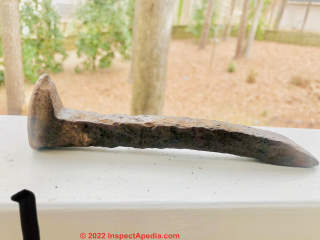
...
Continue reading at RAILROAD SPIKE HISTORY & ID - questions & answers, or select a topic from the closely-related articles below, or see the complete ARTICLE INDEX.
Or see these
Recommended Articles
- AGE of a BUILDING, HOW to DETERMINE - home
- DOOR HARDWARE AGE
- NAILS, AGE & HISTORY - home
- HORSESHOE & HORSESHOE NAIL AGE
- NAIL AGE DETERMINATION KEY - use this key to guess at the age of your nail or spike
- NAIL ID & AGE: CUT NAILS
- NAIL ID & AGE: HAND FORGED NAILS
- NAILS in BARTER & TRADE
- NAIL & HARDWARE CLEAN-UP
- NAILS & HARDWARE, AGE RESEARCH
- RAILROAD SPIKES
- RAILROAD SPIKE AGE - CONTEXTUAL CLUES
- SAW & AXE CUTS, TOOL MARKS, AGE
- WINDOW HARDWARE AGE
Suggested citation for this web page
RAILROAD SPIKE AGE - CONTEXTUAL CLUES at InspectApedia.com - online encyclopedia of building & environmental inspection, testing, diagnosis, repair, & problem prevention advice.
Or see this
INDEX to RELATED ARTICLES: ARTICLE INDEX to BUILDING AGE
Or use the SEARCH BOX found below to Ask a Question or Search InspectApedia
Ask a Question or Search InspectApedia
Try the search box just below, or if you prefer, post a question or comment in the Comments box below and we will respond promptly.
Search the InspectApedia website
Note: appearance of your Comment below may be delayed: if your comment contains an image, photograph, web link, or text that looks to the software as if it might be a web link, your posting will appear after it has been approved by a moderator. Apologies for the delay.
Only one image can be added per comment but you can post as many comments, and therefore images, as you like.
You will not receive a notification when a response to your question has been posted.
Please bookmark this page to make it easy for you to check back for our response.
IF above you see "Comment Form is loading comments..." then COMMENT BOX - countable.ca / bawkbox.com IS NOT WORKING.
In any case you are welcome to send an email directly to us at InspectApedia.com at editor@inspectApedia.com
We'll reply to you directly. Please help us help you by noting, in your email, the URL of the InspectApedia page where you wanted to comment.
Citations & References
In addition to any citations in the article above, a full list is available on request.
- Our recommended books about building & mechanical systems design, inspection, problem diagnosis, and repair, and about indoor environment and IAQ testing, diagnosis, and cleanup are at the InspectAPedia Bookstore. Also see our Book Reviews - InspectAPedia.
- In addition to citations & references found in this article, see the research citations given at the end of the related articles found at our suggested
CONTINUE READING or RECOMMENDED ARTICLES.
- Carson, Dunlop & Associates Ltd., 120 Carlton Street Suite 407, Toronto ON M5A 4K2. Tel: (416) 964-9415 1-800-268-7070 Email: info@carsondunlop.com. Alan Carson is a past president of ASHI, the American Society of Home Inspectors.
Thanks to Alan Carson and Bob Dunlop, for permission for InspectAPedia to use text excerpts from The HOME REFERENCE BOOK - the Encyclopedia of Homes and to use illustrations from The ILLUSTRATED HOME .
Carson Dunlop Associates provides extensive home inspection education and report writing material. In gratitude we provide links to tsome Carson Dunlop Associates products and services.


